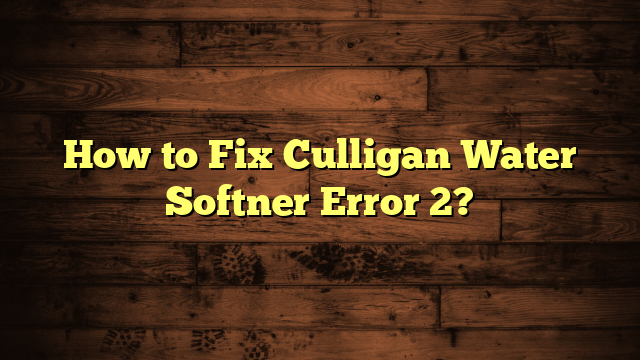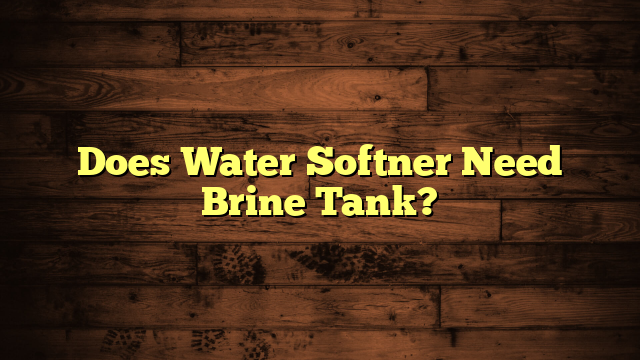How to Fix Culligan Water Softner Error 2?
If you're dealing with Culligan Water Softener Error 2, it's important to tackle it methodically. Start by checking the salt levels in the brine tank, as inadequate salt can lead to this error. You'll also want to inspect for any blockages or salt bridging that could disrupt the regeneration process. But what if these simple checks don't resolve the issue? There are other factors at play that might be causing the problem, and understanding them can save you time and frustration. Let's explore those next.
Key Takeaways
- Check and maintain appropriate salt levels in the brine tank, ensuring it's 6-12 inches above the water line.
- Inspect the brine tank for clogs, salt bridges, and crystallized salt that may hinder performance.
- Verify electrical connections and ensure the unit is properly plugged in and receiving power.
- Clean the brine tank every six months to remove residue and prevent future clogs.
- Reset the water softener by turning off the power, holding the 'Regen' button, and then turning it back on.
Understanding Error 2
When your Culligan water softener displays Error 2, it signals a problem that needs immediate attention. This error code typically indicates an issue related to the unit's salt levels or a malfunction in the regeneration cycle.
To resolve this, you'll want to check the salt tank first. Confirm it's filled with the appropriate type of salt and doesn't have any clumps or bridging, which can impede functionality.
Regular maintenance is essential for preventing these error codes from occurring. For instance, keeping the brine tank clean can help avoid clogs that lead to issues.
You should also inspect the resin beads for wear and tear, as they can affect the softening process.
Another useful maintenance tip is to periodically check the system's settings to make sure they're aligned with your water usage needs. This proactive approach can save you from encountering Error 2 again.
If you've followed these tips and the error persists, it may be wise to consult a professional. Understanding these aspects of your Culligan water softener keeps your system running smoothly and efficiently.
Common Causes of Error 2
When you're dealing with Error 2 on your Culligan water softener, a few common culprits might be causing the issue.
You might find that incorrect salt levels, a clogged resin tank, or problems with electrical connections are to blame.
Identifying these causes can help you get your system back on track quickly and efficiently.
Incorrect Salt Level
An incorrect salt level in your Culligan water softener can lead to Error 2, which often indicates that the system isn't functioning properly due to insufficient or excessive salt.
Maintaining the right salt level is essential for effective water softening. If you're using the wrong salt types, such as table salt or rock salt, this could also cause issues. These salts can leave residue and affect performance, so stick to high-purity salt designed for water softeners.
To avoid Error 2, regularly check the salt level in your brine tank. Aim to keep it at least one-quarter full, but not over the maximum line. If you notice the salt is low, refill it with the appropriate salt type.
Furthermore, consider these maintenance tips: clean the brine tank every six months to prevent clogs and check for bridging, where salt forms a solid mass and isn't dissolving properly.
Clogged Resin Tank
A clogged resin tank can also trigger Error 2 in your Culligan water softener. When the resin beads become blocked with debris, they can't effectively soften the water. This can lead to decreased performance and the error message you're seeing. Regular resin maintenance and tank cleaning are essential in preventing this issue.
To help you understand the common causes of a clogged resin tank, here's a quick reference table:
| Common Cause | Description | Prevention Tips |
|---|---|---|
| Mineral Buildup | Hard minerals accumulate on resin | Use quality salt and softener |
| Debris from Water | Dirt and sand enter the tank | Install a pre-filter |
| Old Resin Beads | Resin loses effectiveness over time | Replace resin every 5-10 years |
| High Iron Content | Excess iron can clog resin beads | Use an iron filter |
| Improper Backwash | Inadequate cleaning of the tank | Follow the manufacturer's guidelines |
Electrical Connection Issues
Experiencing Error 2 in your Culligan water softener might stem from electrical connection issues. Often, the problem is linked to wiring issues or loose connections that disrupt the power supply to your unit.
Start by checking all electrical connections to verify they're securely attached.
Here are a few common signs of electrical connection issues:
- Frayed or damaged wires that show wear and tear.
- Loose connections that might wiggle or pull apart easily.
- Corrosion on terminals that could impede electrical flow.
If you find any of these issues, it's crucial to address them immediately.
Make sure to unplug your softener before inspecting the wiring to avoid any risk of electric shock. Tightening loose connections can often resolve the issue, but if you see damaged wires, you may need to replace them entirely.
If you're uncomfortable working with electrical components, it's best to call a professional.
Regular maintenance can help prevent these issues and keep your water softener running smoothly. By being proactive, you can verify that your unit continues to perform at its best, providing you with soft, quality water.
Initial Troubleshooting Steps
When dealing with a Culligan water softener error 2, it's essential to start with some straightforward troubleshooting steps.
First, check the display panel for any additional messages or codes. This could give you insight into the problem.
Next, verify that the unit is plugged in securely and that the power supply is functioning. Sometimes, a simple power reset can resolve minor issues.
You should also inspect the water quality. If your water source has recently changed, it might affect the softener's performance. For instance, increased sediment or unusual chemicals can trigger errors.
Keep a record of any changes in your water quality, as this information can be significant for troubleshooting.
Additionally, review your maintenance tips. Regular maintenance can prevent many issues from arising in the first place.
Confirm that you're following the recommended schedule for cleaning and servicing your unit. If you notice any leaks or unusual noises while the system is running, take note of these as well.
These initial troubleshooting steps can often resolve the error and get your water softener back to peak performance.
If the problem persists, you may need to explore deeper into the issue.
Checking the Salt Levels
Salt levels play a critical role in the functionality of your Culligan water softener, and checking them should be one of your first steps in troubleshooting error 2. Without adequate salt, your system can't effectively soften water, leading to potential issues.
Here's what you should look for:
- Visible Salt Crust: Look for any crusty buildup on the surface, which indicates low salt levels.
- Salt Bridge: Check for any hardened layers that may be preventing salt from dissolving properly.
- Salt Types: Confirm you're using the right type of salt—solar, evaporated, or rock salt can each have different impacts on performance.
Regular maintenance tips include visually inspecting the salt levels at least once a month.
Aim to keep the salt level above the water level, as this guarantees efficient operation. If you find that your softener frequently runs low on salt, consider setting a reminder to refill it.
Taking these simple steps can help you avoid the frustrations of error 2 and keep your water softener running smoothly.
Inspecting the Brine Tank
To fix the Culligan water softener error, start by inspecting the brine tank closely.
You'll want to check the salt levels to verify they're adequate, and also look for any blockages that might be affecting performance.
Check Salt Levels
Checking the brine tank is essential for maintaining your Culligan water softener's efficiency. If the salt levels are too low, your system won't function properly, leading to issues like Error 2.
Regularly inspect the brine tank and verify you're using the right salt types for peak performance.
Here are some maintenance tips to keep in mind:
- Visual Check: Look inside the tank for salt crust or bridges, which can prevent proper water flow.
- Salt Level: Verify the salt level is above the water level in the brine tank. Ideally, there should be about 6-12 inches of salt above the water.
- Type of Salt: Use high-purity salt pellets or crystals specifically designed for water softeners to avoid build-up and clogs.
Inspect for Blockages
After confirming your salt levels are adequate, the next step involves inspecting the brine tank for any blockages. Blockage detection is essential because even minor clogs can hinder your water softener's performance. Start by checking the brine tank for salt bridges or any buildup that might obstruct the flow.
Here's a quick reference table to help you identify potential issues:
| Issue | Solution |
|---|---|
| Salt Bridge | Break it up with a broom |
| Crystallized Salt | Remove and clean the tank |
| Blocked Pipes | Perform a pipe inspection |
| Residue Build-up | Rinse the tank thoroughly |
| Low Water Levels | Refill the tank with water |
Make sure to look for any signs of blockage in the connecting pipes, as they can also restrict water flow. If you find any clogs, address them promptly to avoid further complications. Regularly inspecting the brine tank not only helps maintain efficiency but also extends the life of your water softener. By staying proactive, you can guarantee peak performance and avoid future errors.
Resetting the Water Softener
Resetting your Culligan water softener is a straightforward process that can resolve Error 2 efficiently. By using effective resetting techniques, you can restore your unit's functionality and guarantee proper softener maintenance.
Start by locating the control panel on your water softener. Once you've found it, follow these simple steps:
- Turn off the power to the unit, giving it a moment to reset completely.
- Press and hold the 'Regen' button for about five seconds; this initiates the reset process.
- Turn the power back on, and check if the error code disappears.
After these steps, wait for the softener to complete its regeneration cycle. This process typically takes a couple of hours, during which the system will flush out any issues causing Error 2.
Regular maintenance checks will help prevent future errors. Make sure to inspect the brine tank and salt levels frequently, keeping everything clean and topped up.
When to Contact a Professional
Sometimes, despite your best efforts to reset the Culligan water softener and perform regular maintenance, issues may persist. If you've tried troubleshooting the error, yet your softener still shows Error 2, it's time to evaluate when to call for professional help.
Look out for signs that indicate a more serious problem. If you hear unusual noises coming from the unit, or if your water quality hasn't improved after several adjustments, these are clear indicators that you need expert assistance.
Furthermore, if your softener is leaking or has visible signs of damage, don't hesitate to reach out to a professional.
Another significant factor is the age of your unit. If your Culligan water softener is older and has required frequent repairs, it might be worth consulting with a technician about its overall viability. They can provide insights on whether it's time for a replacement or if repairs are feasible.
In short, if you've exhausted all options—resetting, cleaning, and checking for clogs—it's time to call in the pros.
Professional help can save you time and money, ensuring your water softener operates efficiently again.
Frequently Asked Questions
What Is the Lifespan of a Culligan Water Softener?
A Culligan water softener typically lasts 10 to 15 years with proper maintenance. To enhance water softener longevity, you should regularly check salt levels, clean the brine tank, and schedule professional maintenance when needed.
Can Error 2 Affect Water Quality?
Like a storm cloud looming overhead, error 2 can impact water quality. If you notice changes in taste or clarity, it's essential to address the issue promptly to maintain your water's purity and safety.
How Often Should I Maintain My Water Softener?
You should perform water softener maintenance every six months for peak performance. Create a maintenance schedule to check salt levels, clean the system, and inspect for leaks, ensuring your water stays soft and quality remains high.
Is There a Warranty for Culligan Water Softeners?
Think of a warranty as a safety net for your water softener. Culligan offers warranty coverage, but be mindful of warranty limitations. Check your specific model's terms to understand what's covered and what isn't.
What Are the Signs of a Failing Water Softener?
If you notice increased water hardness, frequent salt replenishment, or strange noises, your water softener might be failing. Regular maintenance tips can help prolong its life and guarantee peak performance. Don't ignore these signs!
Conclusion
By following these steps, you can tackle Culligan Water Softener Error 2 like a pro. Think of it as a puzzle; with each check, you're piecing together the solution. Remember, keeping the salt levels right and the brine tank clean is key to smooth operation. If issues persist, don't hesitate to call in the experts. After all, a fully functioning water softener is like a well-tuned instrument, ensuring your home runs harmoniously.







